两个特性
用户可控制反序列化的对象
user类如下:
1
2
3
4
5
6
7
8
9
10
11
12
13
14
15
16
17
18
19
20
21
22
23
24
25
26
27
28
29
30
31
32
33
34
35
36
37
38
39
40
41
42
43
44
45
46
47
48
49
50
51
52
53
54
55
56
57
| package org.example;
public class user {
private String name;
private int age;
private String hobby;
public user() {
System.out.println("user构造函数user(无参数)");
}
public user(String name, int age, String hobby) {
System.out.println("user构造函数user(有参数)");
this.name = name;
this.age = age;
this.hobby = hobby;
}
public String getName() {
System.out.println("user调用了getName");
return name;
}
public void setName(String name) {
System.out.println("user调用了setName");
this.name = name;
}
public int getAge() {
System.out.println("user调用了getAge");
return age;
}
public void setAge(int age) {
System.out.println("user调用了setAge");
this.age = age;
}
public String getHobby() {
System.out.println("user调用了getHobby");
return hobby;
}
public void setHobby(String hobby) {
System.out.println("user调用了setHobby");
this.hobby = hobby;
}
@Override
public String toString() {
return "user{" +
"name='" + name + '\'' +
", age=" + age +
", hobby='" + hobby + '\'' +
'}';
}
}
|
然后是调用函数,我都是写在各种小test里,然后在main中调用
1
2
3
4
5
6
7
8
9
10
11
12
13
14
| package org.example;
import com.alibaba.fastjson.JSON;
import com.alibaba.fastjson.serializer.SerializerFeature;
public class Main {
public static void main(String[] args) {
test3();
}
}
|
安全的使用方法:
先看正确的使用方法:
1
2
3
4
5
6
| public static void test3(){
String p1 = "{\"age\":18,\"hobby\":\"gaming\",\"name\":\"y\"}";
user tmpuser = JSON.parseObject(p1, user.class);
System.out.println(tmpuser.getAge());
}
|
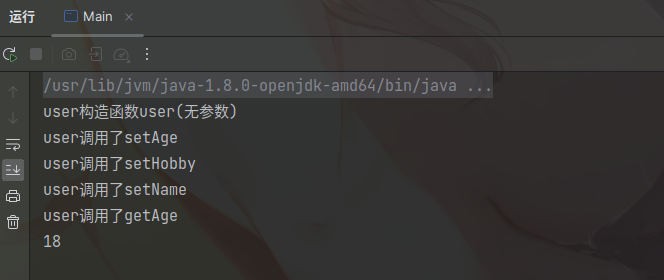
可以看到输出中,出现了
user构造函数user(无参数)
这是因为需要构造user对象tmpuser。
user调用了setAge user调用了setHobby user调用了setName
这三个出现,是因为在构造过程中,给age,name,hobby这三个属性赋值了。
user调用了getAg
18
是tmpuser.getAge()这一行输出的。
限制死了反序列化的类型为user,这种由开发者控制的反序列化的类型,是安全的。
不安全的使用方法:
因为fastjson有一个特性,可以由用户指定反序列化的类型,通过@type字段。可以先设置另一个user2对象
代码如下
1
2
3
4
5
6
7
8
9
10
11
12
13
14
15
16
17
18
19
20
21
22
23
24
25
26
27
28
29
30
31
32
33
34
35
36
37
38
39
40
41
42
43
44
45
46
47
48
49
50
51
52
53
54
55
56
57
| package org.example;
public class user2 { private String name;
private int age;
private String hobby;
public user2() {
System.out.println("user2构造函数user2(无参数)");
}
public user2(String name, int age, String hobby) {
System.out.println("user2构造函数user2(有参数)");
this.name = name;
this.age = age;
this.hobby = hobby;
}
public String getName() {
System.out.println("user2调用了getName");
return name;
}
public void setName(String name) {
System.out.println("user2调用了setName");
this.name = name;
}
public int getAge() {
System.out.println("user2调用了getAge");
return age;
}
public void setAge(int age) {
System.out.println("user2调用了setAge");
this.age = age;
}
public String getHobby() {
System.out.println("user2调用了getHobby");
return hobby;
}
public void setHobby(String hobby) {
System.out.println("user2调用了setHobby");
this.hobby = hobby;
}
@Override
public String toString() {
return "user{" +
"name='" + name + '\'' +
", age=" + age +
", hobby='" + hobby + '\'' +
'}';
}
}
|
然后是调用代码:
1
2
3
4
5
6
7
8
| public static void test4() {
String p1 = "{\"@type\":\"org.example.user\",\"age\":18,\"hobby\":\"gaming\",\"name\":\"y\"}";
String p2 = "{\"@type\":\"org.example.user2\",\"age\":18,\"hobby\":\"gaming\",\"name\":\"y\"}";
System.out.println("JSON.parse(p1):");
Object P1 = JSON.parse(p1);
System.out.println("JSON.parse(p2):");
Object P2 = JSON.parse(p2);
}
|
输出结果如下:
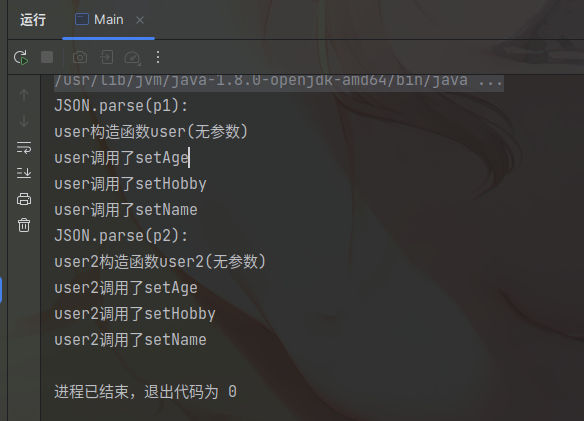
可以将test()理解为一个函数,用户输入序列号后的字符串交给服务器,服务器对字符串进行反序列化,这里输入的p1,p2就可以理解为调用了两次函数。
调用getName方法
但反序列化字符串的函数不是parse而是parseObject时,就会调用对象中的getter类方法,比如getName,getAge,getHobby。
1
2
3
4
5
6
7
| public static void test6() {
String p1 = "{\"@type\":\"org.example.user\",\"age\":18,\"hobby\":\"gaming\",\"name\":\"y\"}";
System.out.println("JSON.parse(p1):");
Object P1 = JSON.parse(p1);
System.out.println("JSON.parseObject(p1):");
Object P2 = JSON.parseObject(p1);
}
|
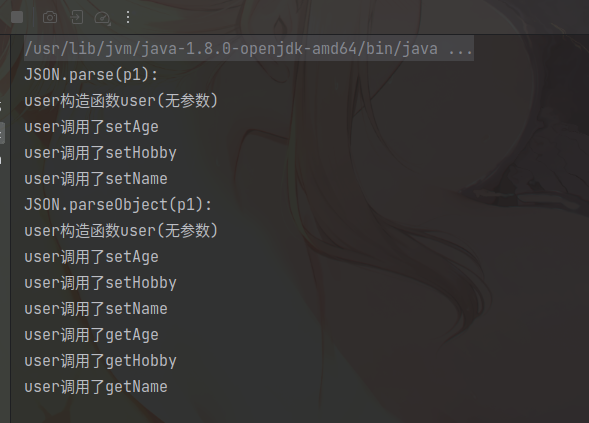
在了解这两种机制后,就可能会出现下面这种情况:代码中出现了 JSON.parseObject(p1); 可能设计初衷只是想解析反序列化”{"age":18,"hobby":"gaming","name":"y"}”这样的字符串,但是因为这两个特性,就可能出现一些意想不到的结果
调用流程分析
先来捋顺正常的调用,再来看漏洞的调用
正常流程
识别@type
使用如下代码,
1
2
3
4
5
| public static void test7(){
String p1 = "{\"@type\":\"org.example.user\",\"age\":18,\"hobby\":\"gaming\",\"name\":\"y\"}";
System.out.println("JSON.parseObject(p1):");
Object P2 = JSON.parseObject(p1);
}
|
断点下载 Object P2 = JSON.parseObject(p1);
前面都是普通的调来调去,一直到这里
1
2
3
4
5
6
7
8
9
10
| public Object parse(Object fieldName) {
final JSONLexer lexer = this.lexer;
switch (lexer.token()) {
…………
…………
case LBRACE:
JSONObject object = new JSONObject(lexer.isEnabled(Feature.OrderedField));
return parseObject(object, fieldName);
…………
…………
|
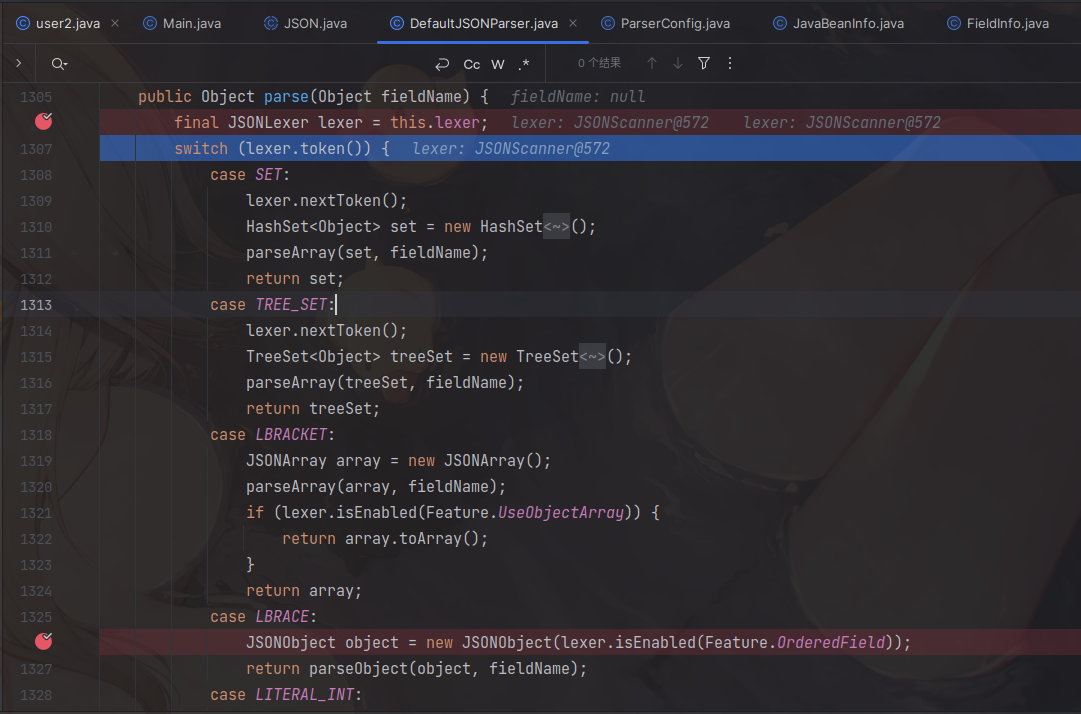
这里的lexer是由之前JSON.java中的
DefaultJSONParser parser = new DefaultJSONParser(text, ParserConfig.getGlobalInstance(), features);
这一行定义和赋值
在swtich中,识别到第一个字符串是{ (也就是 LBRACE )后,通过
return parseObject(object, fieldName);
进入到了parseObject函数中,这个函数还是在当前DefaultJSONParser.java文件中
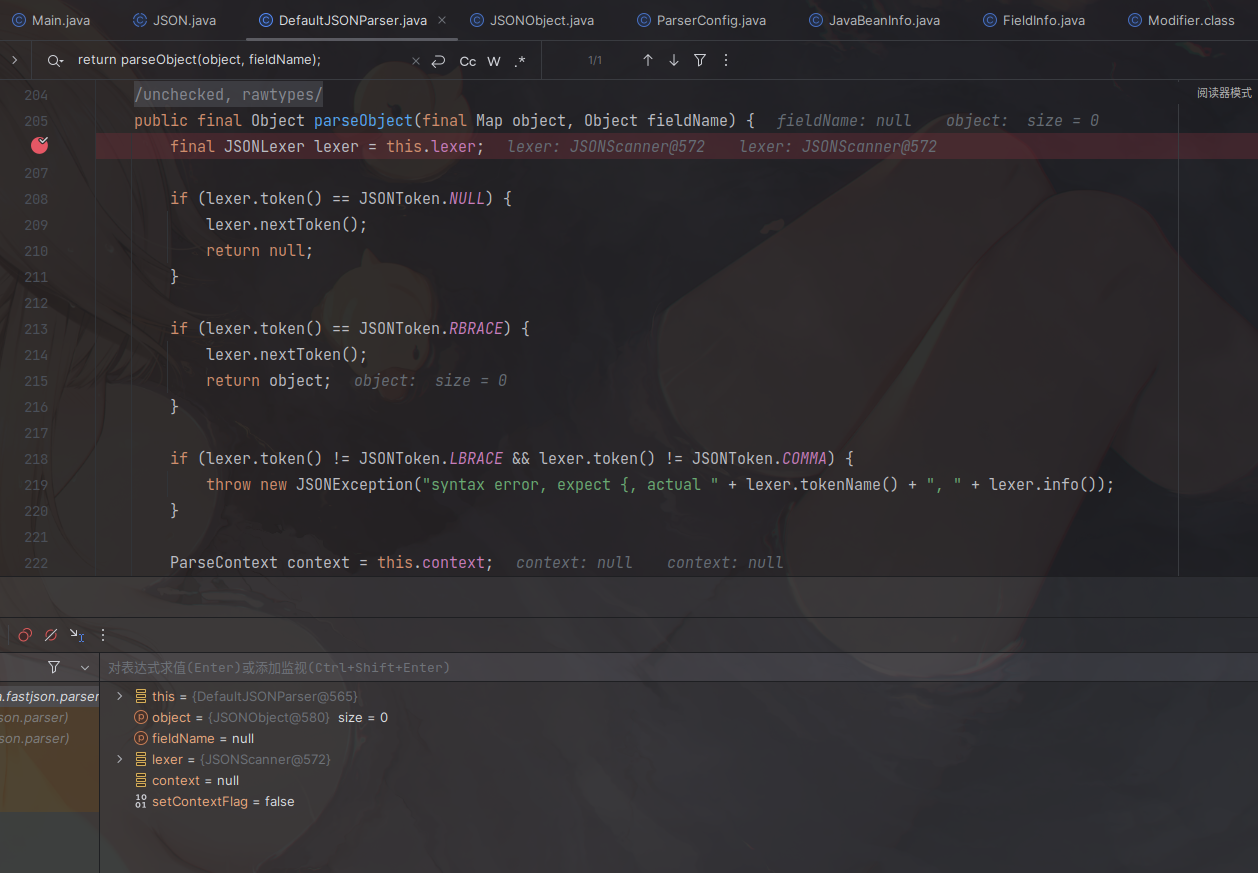
经过几个判断后,进入到try finally 代码块中,这里面是一个for(;;)死循环,然后可以看到有一个判断
1
2
3
4
5
6
7
8
9
10
| if (key == JSON.DEFAULT_TYPE_KEY && !lexer.isEnabled(Feature.DisableSpecialKeyDetect)) {
String typeName = lexer.scanSymbol(symbolTable, '"');
Class<?> clazz = TypeUtils.loadClass(typeName, config.getDefaultClassLoader());
if (clazz == null) {
object.put(JSON.DEFAULT_TYPE_KEY, typeName);
continue;
}
………………
………………
|
JSON.DEFAULT_TYPE_KEY是@type
lexer.isEnabled()会返回入参的mask字段,这边的Feature.DisableSpecialKeyDetect内容如下,所以!lexer.isEnabled(Feature.DisableSpecialKeyDetect)的结果为true
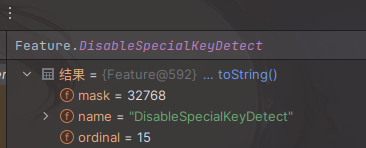
随后就获取到@type的value:org.example.user
这边的意思大概就是,通过识别到{开头,然后开始进行反序列化的字符从识别,识别到@type,意味着需要指定类进行java反序列化。这边的下一行
Class<?> clazz = TypeUtils.loadClass(typeName, config.getDefaultClassLoader());
就是加载制定的类以便于反序列化
加载指定类
在上面用loadlass加载完类后,继续这个if代码块,在最下面有一个
1
2
| ObjectDeserializer deserializer = config.getDeserializer(clazz);
return deserializer.deserialze(this, clazz, fieldName);
|
这边是为了获取反序列化器deserializer,跟进getDeserializer,因为type instanceof Class<?>,跳到 getDeserializer((Class<?>) type, type)中,
在这个getDeserializer,会经过一些替换处理,if判断,比如说会把$换成.
- className = className.replace(‘$’, ‘.’);
会检测是否java.awt.开头等等。
最后因为传入的value是org.example.user,流程会来到461行的
derializer = createJavaBeanDeserializer(clazz, type);
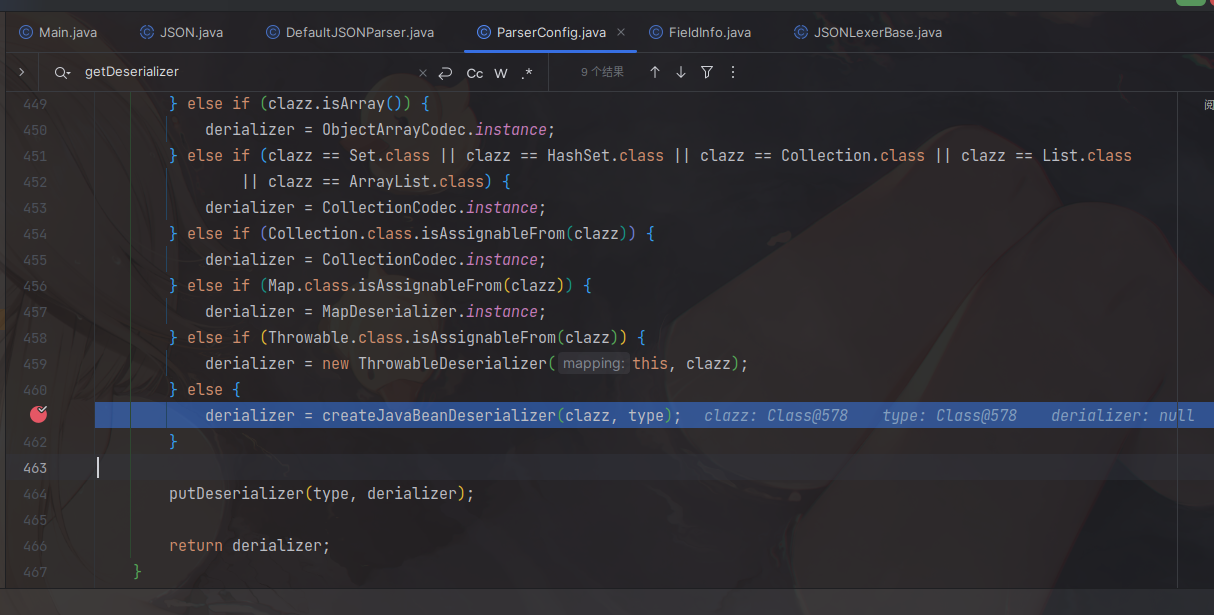
跟进createJavaBeanDeserializer(),这个函数里的判断主要是围绕 asmEnable 变量的true和false来进行的,在一系列的处理后,来到了
1
| JavaBeanInfo beanInfo = JavaBeanInfo.build(clazz, type, propertyNamingStrategy);
|
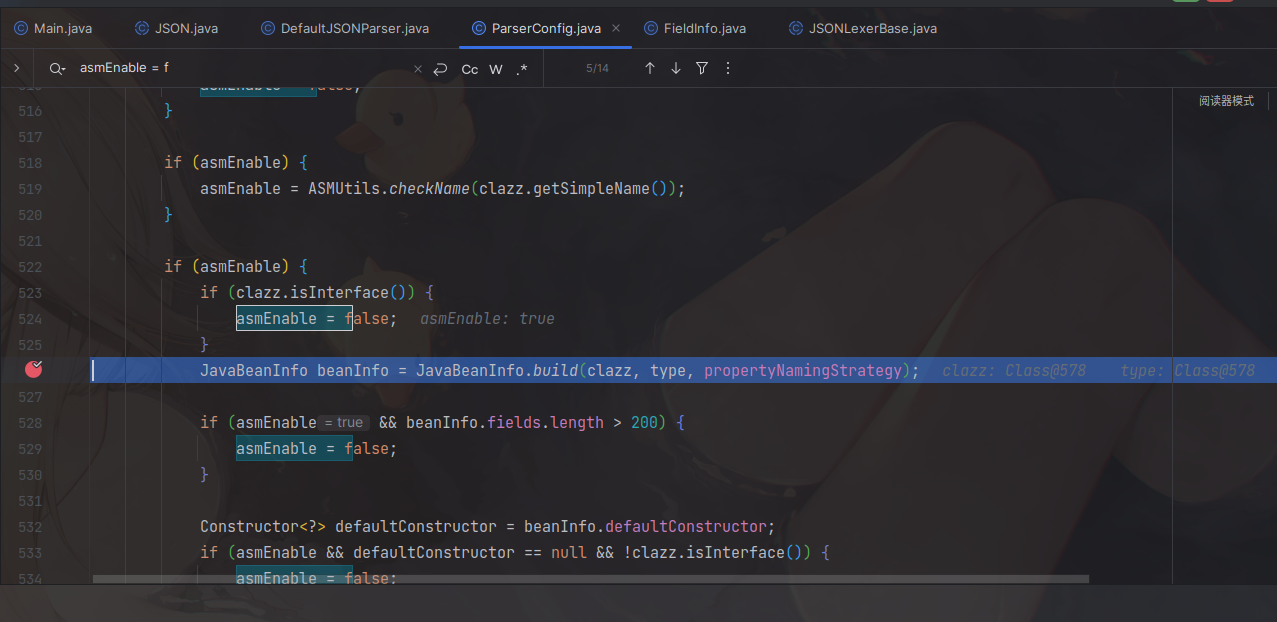
跟进这个build()函数,这函数内容也非常多,不过因为两个长的 if 代码块不会运行,所以可以忽略,重点是下面的三个 for 代码块,
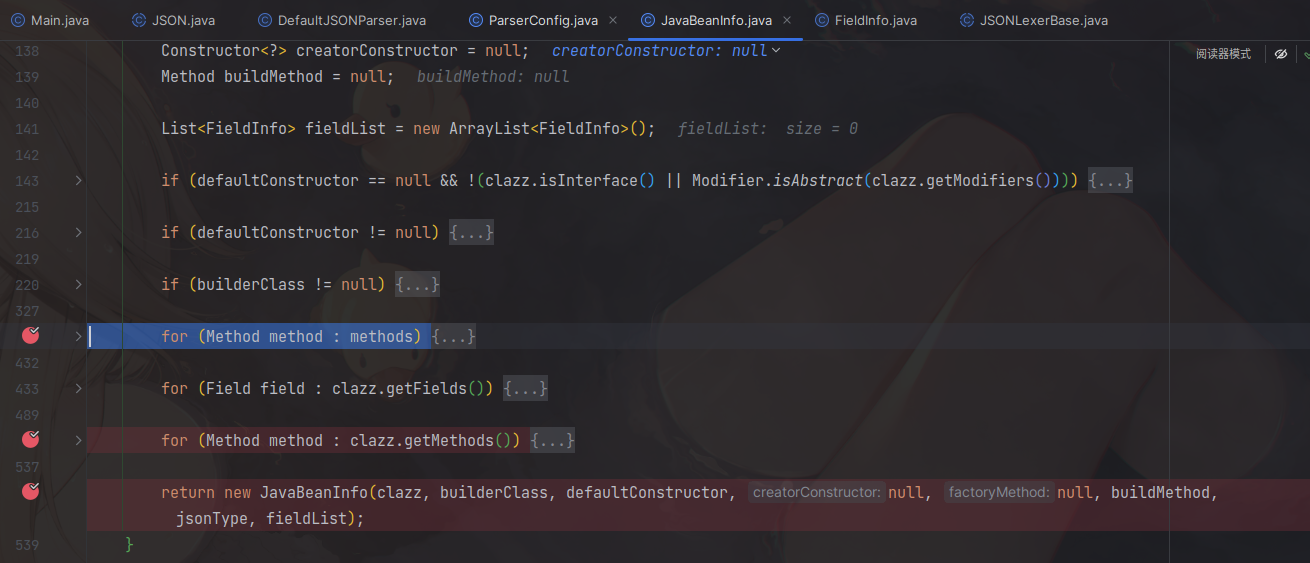
其中第一个循环 for (Method method : methods) 是在指定的java类中找setter类方法。那些“函数命名以set开头,第四个字母大写”之类的条件,应该就是在这里进行判断处理的。
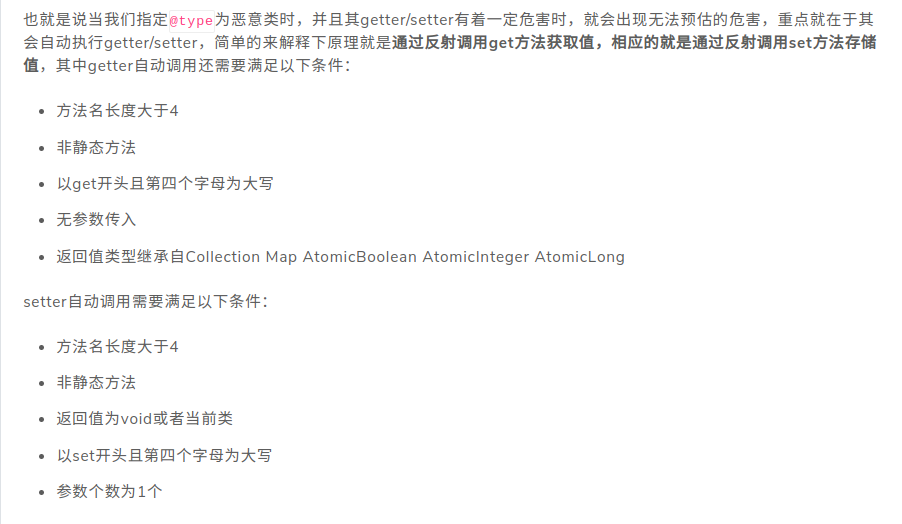
1
2
3
4
5
6
7
8
9
10
11
12
13
14
15
16
17
18
19
20
21
22
23
24
25
26
27
28
29
30
31
32
33
34
35
36
37
38
39
40
41
42
43
44
45
46
47
48
49
50
51
52
53
54
55
56
57
58
59
60
61
62
63
64
65
| String methodName = method.getName();
if (methodName.length() < 4) {
continue;
}
if (Modifier.isStatic(method.getModifiers())) {
continue;
}
if (!(method.getReturnType().equals(Void.TYPE) || method.getReturnType().equals(method.getDeclaringClass()))) {
continue;
}
Class<?>[] types = method.getParameterTypes();
if (types.length != 1) {
continue;
}
JSONField annotation = method.getAnnotation(JSONField.class);
if (annotation == null) {
annotation = TypeUtils.getSuperMethodAnnotation(clazz, method);
}
if (annotation != null) {
if (!annotation.deserialize()) {
continue;
}
ordinal = annotation.ordinal();
serialzeFeatures = SerializerFeature.of(annotation.serialzeFeatures());
parserFeatures = Feature.of(annotation.parseFeatures());
if (annotation.name().length() != 0) {
String propertyName = annotation.name();
add(fieldList, new FieldInfo(propertyName, method, null, clazz, type, ordinal, serialzeFeatures, parserFeatures,
annotation, null, null));
continue;
}
}
if (!methodName.startsWith("set")) {
continue;
}
char c3 = methodName.charAt(3);
String propertyName;
if (Character.isUpperCase(c3)
|| c3 > 512
) {
if (TypeUtils.compatibleWithJavaBean) {
propertyName = TypeUtils.decapitalize(methodName.substring(3));
} else {
propertyName = Character.toLowerCase(methodName.charAt(3)) + methodName.substring(4);
}
} else if (c3 == '_') {
propertyName = methodName.substring(4);
} else if (c3 == 'f') {
propertyName = methodName.substring(3);
} else if (methodName.length() >= 5 && Character.isUpperCase(methodName.charAt(4))) {
propertyName = TypeUtils.decapitalize(methodName.substring(3));
} else {
continue;
}
|
在处理的最后,会使用add()将找到的方法加进fieldList中,
1
2
| add(fieldList, new FieldInfo(propertyName, method, field, clazz, type, ordinal, serialzeFeatures, parserFeatures,
annotation, fieldAnnotation, null));
|
第二个for (Field field : clazz.getFields())是遍历所有public的方法,
第三个与第一个类似,不过是getter方法
getonly参数
在构造函数FieldInfo()中,有一个东西需要注意,getonly参数
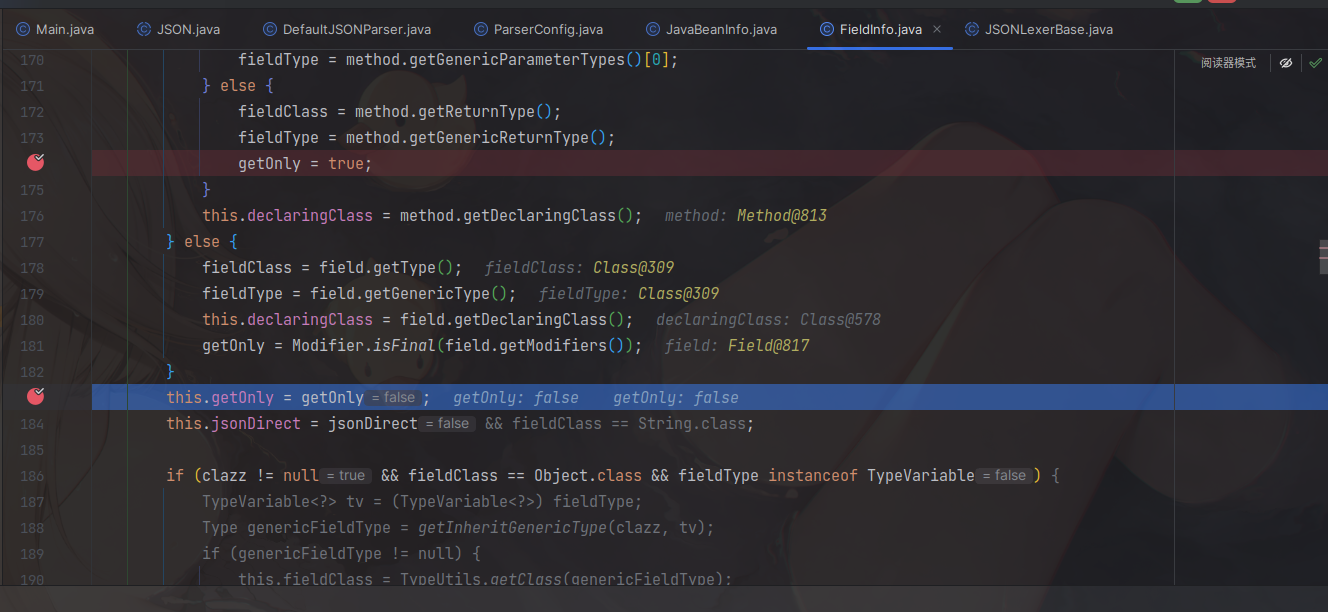
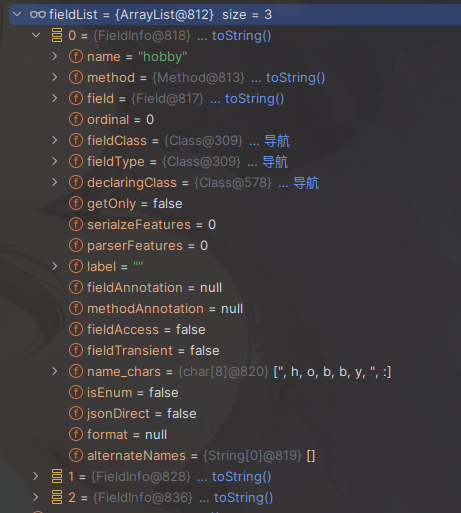
为了后续方便调试,这个参数需要为true,在FieldInfo()中,这个参数为true,需要 method.getParameterTypes()的长度不为1,
1
| if ((types = method.getParameterTypes()).length == 1)
|
然而在第一个for (Method method : methods) 循环中,有这样一个判断
1
2
3
4
| Class<?>[] types = method.getParameterTypes();
if (types.length != 1) {
continue;
}
|
所以在第一个for循环中,是永远不能使getonly为true的。因为如果参数不为1,那就会被continue,代码根本走不到add();如果参数为1,代码在走到了add(),那getonly就只能为false了。
所以需要看第二个for循环。
第二个for循环是找getter函数,构造的函数需要满足以下几个条件
1
2
3
4
5
6
7
8
9
10
11
12
13
14
15
16
17
18
19
20
21
22
23
24
25
26
27
28
29
30
31
32
33
|
if (methodName.length() < 4) {
continue;
}
if (Modifier.isStatic(method.getModifiers())) {
continue;
}
if (methodName.startsWith("get") && Character.isUpperCase(methodName.charAt(3))) {
if (method.getParameterTypes().length != 0) {
continue;
}
if (Collection.class.isAssignableFrom(method.getReturnType())
|| Map.class.isAssignableFrom(method.getReturnType())
|| AtomicBoolean.class == method.getReturnType()
|| AtomicInteger.class == method.getReturnType()
|| AtomicLong.class == method.getReturnType()
) {
…………
FieldInfo fieldInfo = getField(fieldList, propertyName);
if (fieldInfo != null) {
continue;
}
…………
add(fieldList, new FieldInfo(propertyName, method, null, clazz, type, 0, 0, 0, annotation, null, null));
…………
}
|
所以为了试getonly变量为true,所需要构造的getter函数就可以简单写为
1
2
3
4
5
6
7
8
9
10
11
| public AtomicBoolean getKey2(){
AtomicBoolean re = null;
System.out.println("user调用了setKey2");
this.key1 = key1;
this.key2 = key2;
return re;
}
|
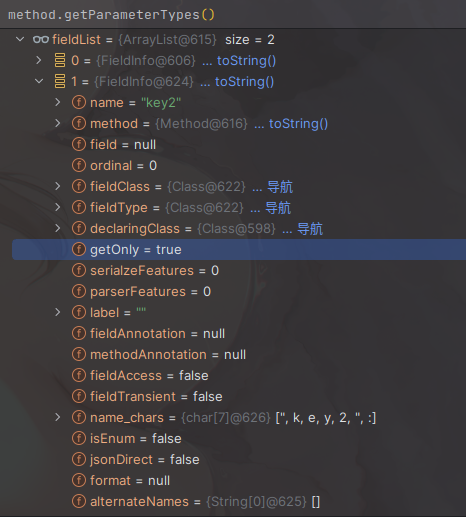
之后,代码跳出JavaBeanInfo beanInfo = JavaBeanInfo.build(clazz, type, propertyNamingStrategy); 向下走到
1
2
3
4
5
6
7
8
9
10
11
| for (FieldInfo fieldInfo : beanInfo.fields) {
if (fieldInfo.getOnly) {
asmEnable = false;
break;
}
…………
}
…………
if (!asmEnable) {
return new JavaBeanDeserializer(this, clazz, type);
}
|
然后就可以将asmEnable设置为false,随后 return new JavaBeanDeserializer(this, clazz, type); 结束函数。
在return的时候,是new了一个新的JavaBeanDeserializer,所以还会在走一边之前的三个for循环那块的流程,然后退出到ParseConfig.java的derializer = createJavaBeanDeserializer(clazz, type);,再继续退出当前的getDeserializer()函数,回到getDeserializer(),最后退出到DefaultJSONParser.java的
1
2
| ObjectDeserializer deserializer = config.getDeserializer(clazz);
return deserializer.deserialze(this, clazz, fieldName);
|
反序列化
通过调整getter函数,使用ObjectDeserializer deserializer = config.getDeserializer(clazz);获取到反序列化器后
退出到DefaultJSONParser.java的return deserializer.deserialze(this, clazz, fieldName);后,
跟进deserialze()方法,跳过一些重载方法后,来到JavaBeanDeserializer.java文件中。走到object = createInstance(parser, type);时。这里是新建一个实例,在这里面有一句object = constructor.newInstance();会执行指定了类的构造方法
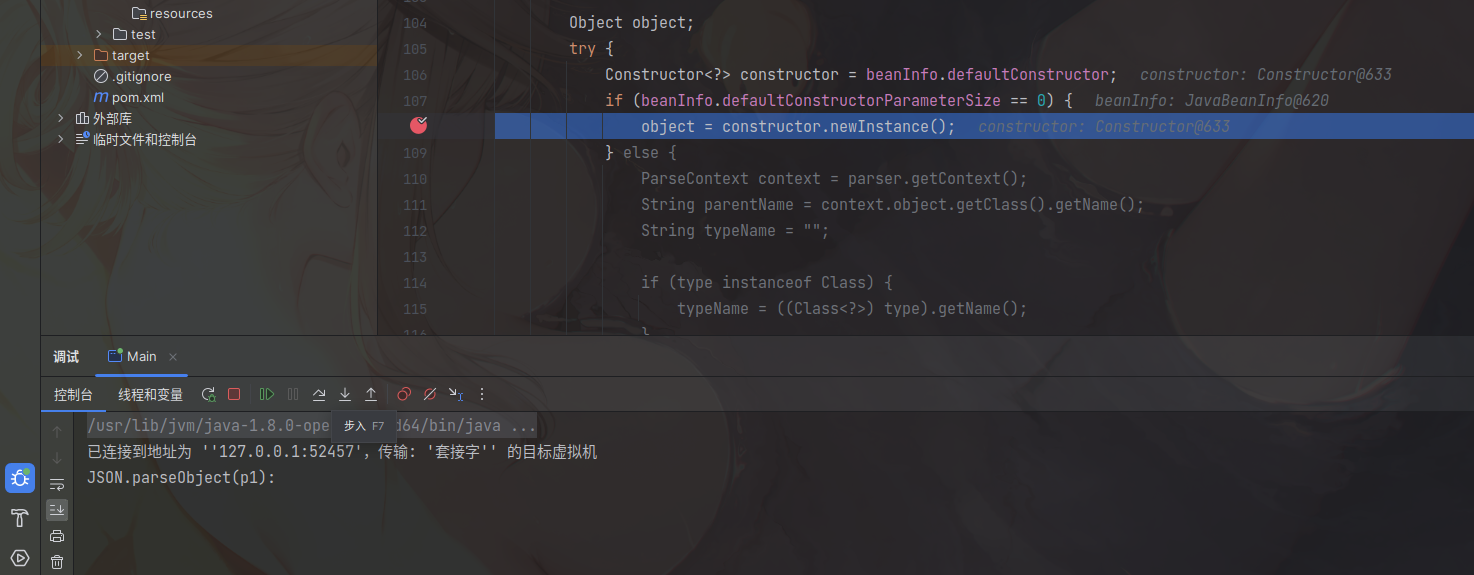
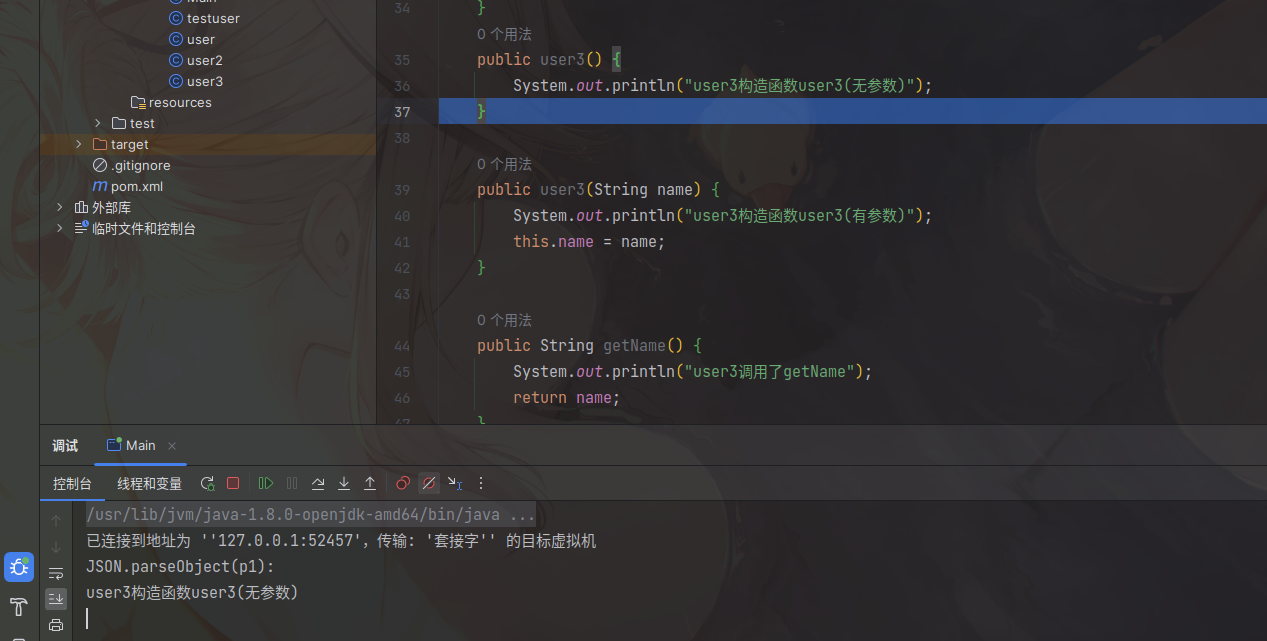
之后在fieldDeser.setValue(object, fieldValue);中跟进,里面在经过层层if判断和其他的处理后,有一行反射代码method.invoke(object, value);
在这执行了之前加入到fieldList的setter函数,
这里是setName
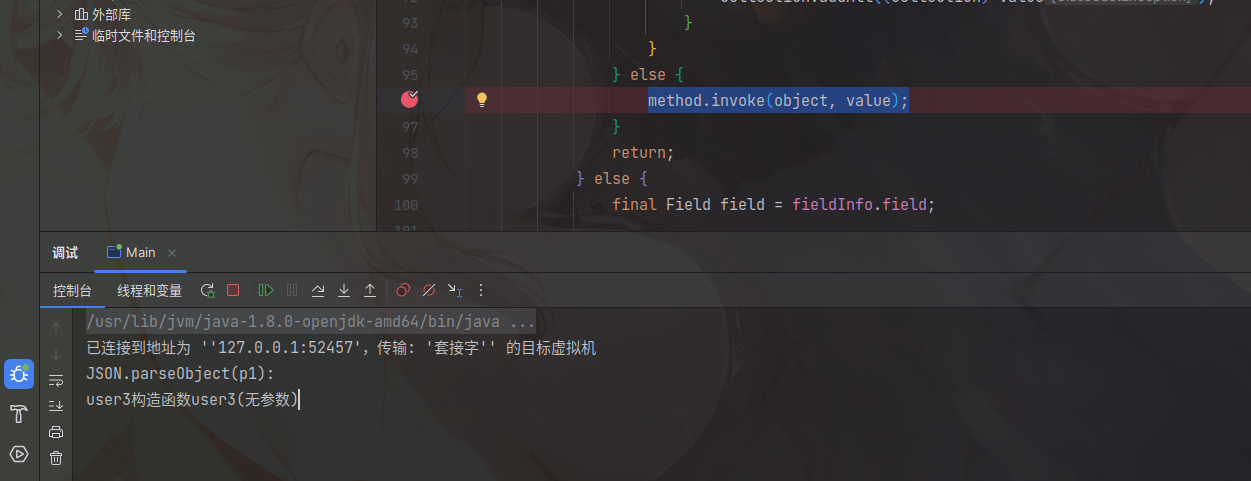
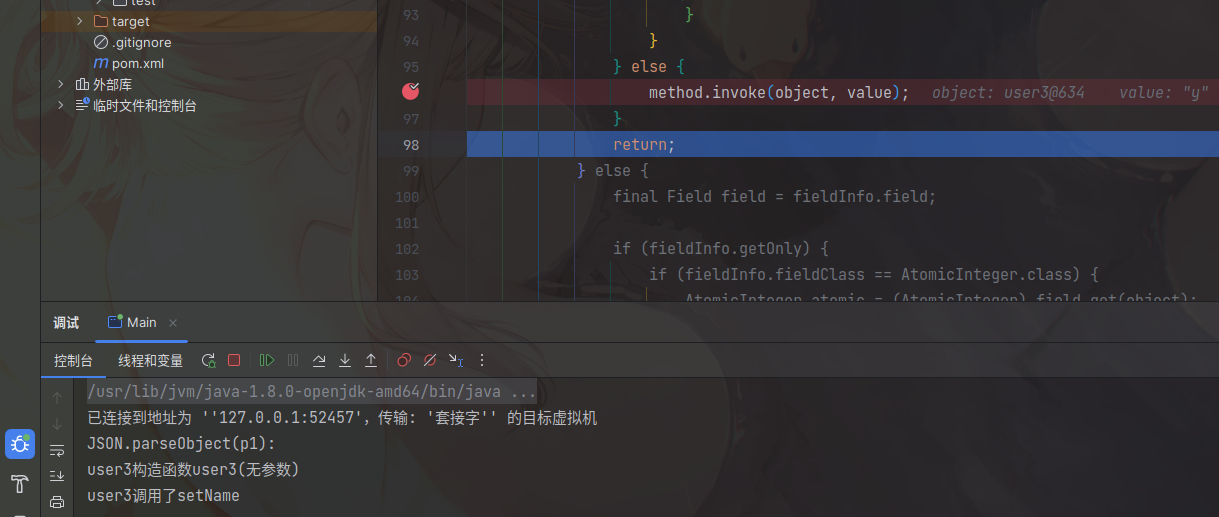
而被执行的getter方法,是在JSON.java的return (JSONObject) JSON.toJSON(obj);中被调用的,在使用parse()将字符串反序列化为对象后,判断对象类型是否是JSON,如果不是,就再使用toJSON()函数处理一下obj。
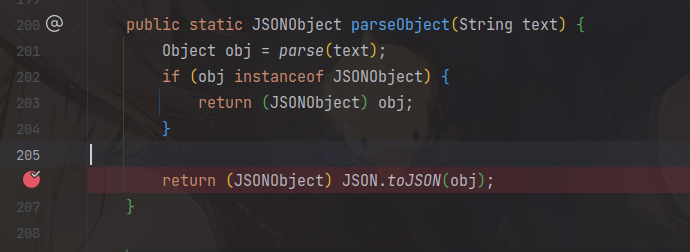
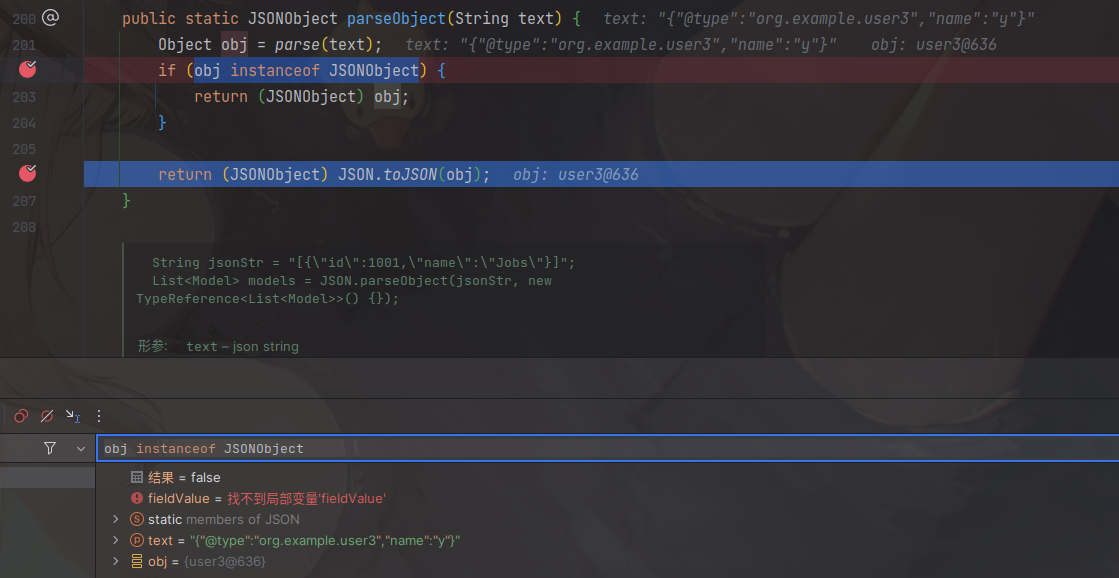
在toJSON中,通过ObjectSerializer serializer = config.getObjectWriter(clazz);获取ObjectSerializer:

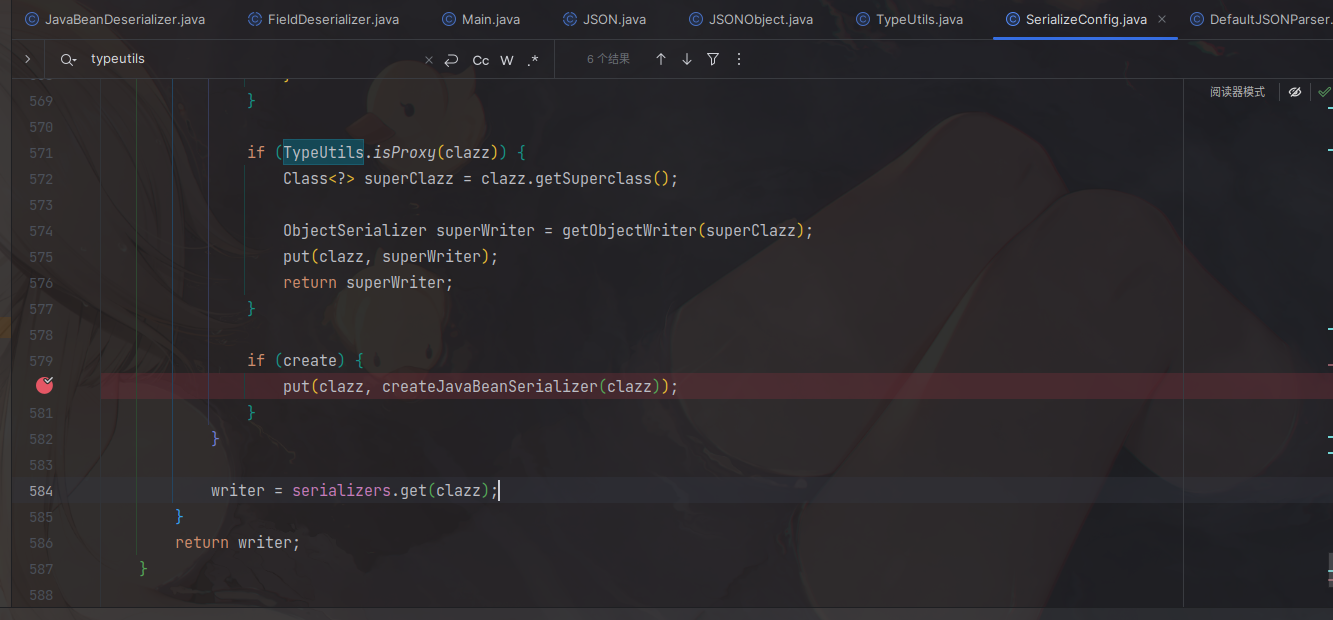

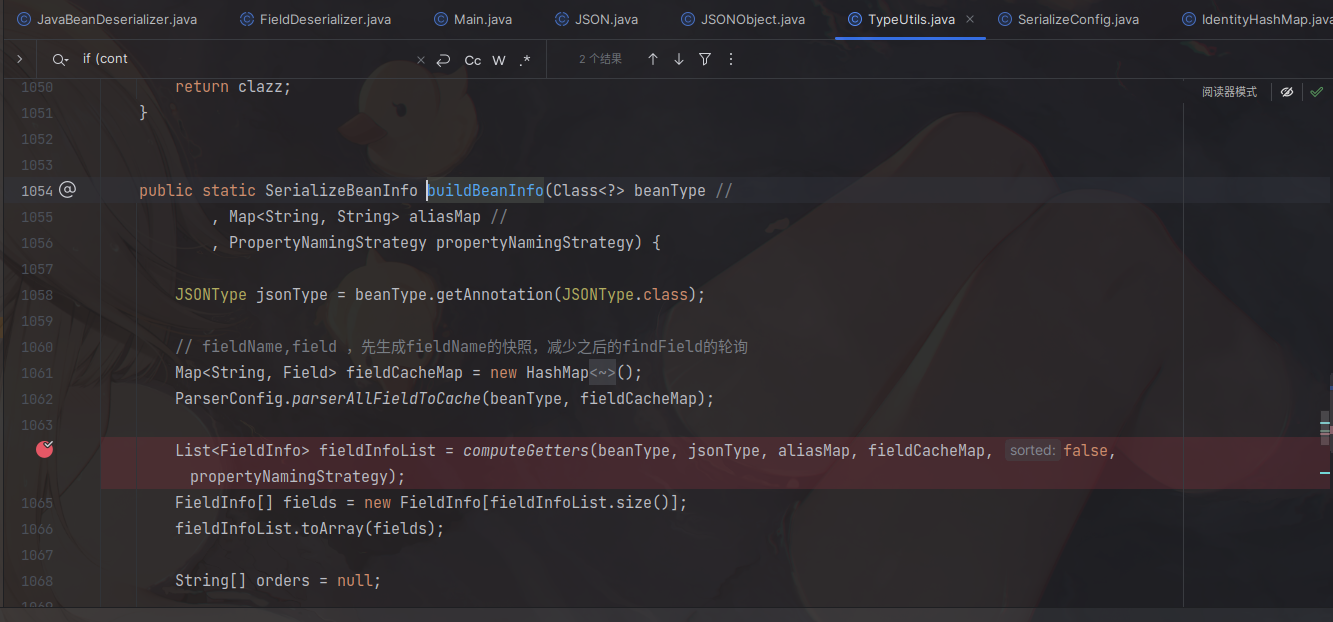

在获取到ObjectSerializer后,在Map<String, Object> values = javaBeanSerializer.getFieldValuesMap(javaObject);里面执行的getter方法,具体来看:
getFieldValuesMap() –> getter.getPropertyValue(object) -> Object propertyValue = fieldInfo.get(object);
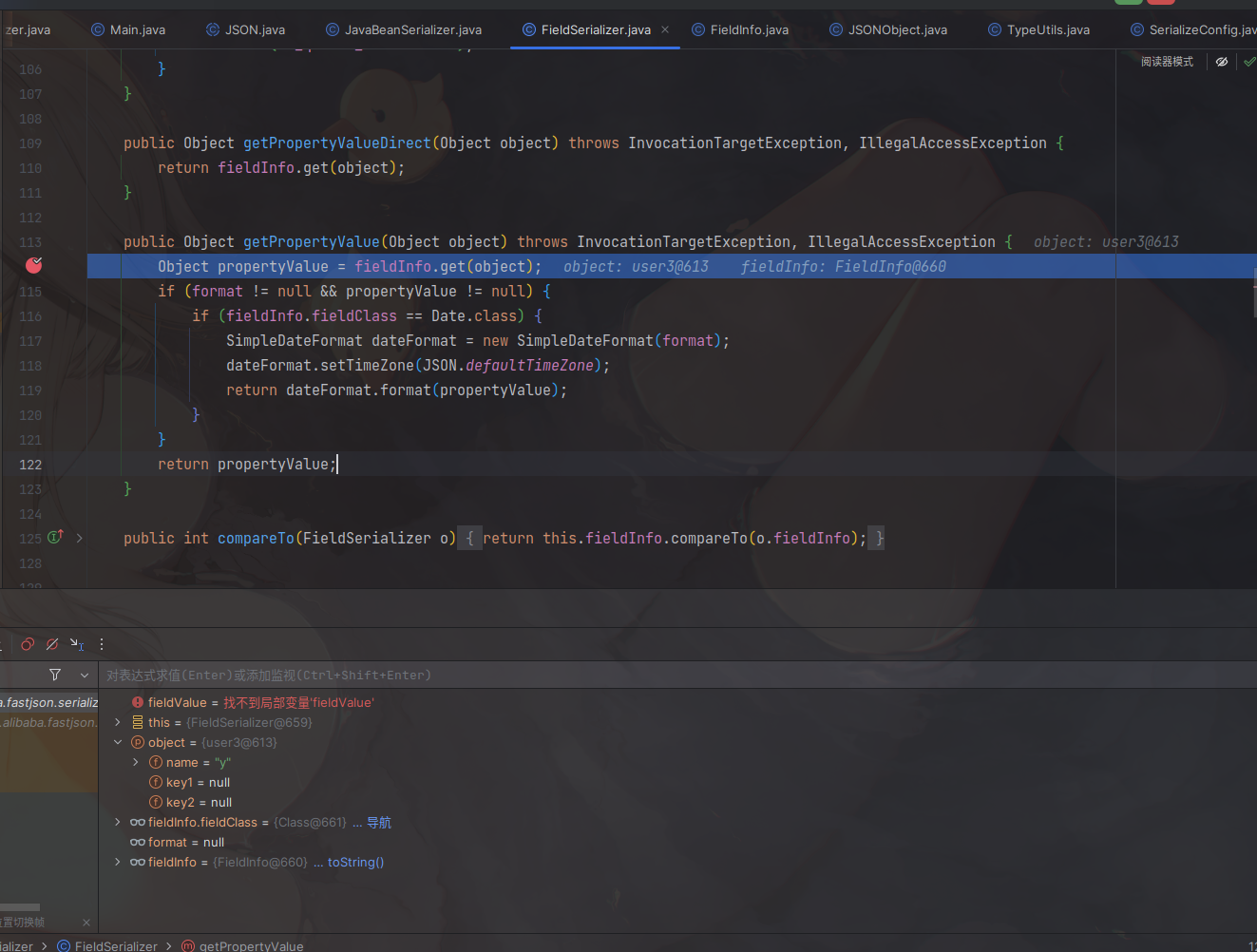
1
2
3
4
5
| public Object get(Object javaObject) throws IllegalAccessException, InvocationTargetException {
if (method != null) {
Object value = method.invoke(javaObject, new Object[0]);
return value;
}
|
测试执行命令
假如说在代码中有一个这样的类
1
2
3
4
5
6
7
8
9
| package org.example;
import java.io.IOException;
public class testcmd {
public void setCmd(String cmd) throws IOException {
Runtime.getRuntime().exec(cmd);
}
}
|
如果想要通过fastjson执行命令,可以这样写
1
2
3
4
| public static void test7(){
String cmd = "{\"@type\":\"org.example.testcmd\",\"cmd\":\"gnome-calculator\"}";
Object P2 = JSON.parseObject(cmd);
}
|
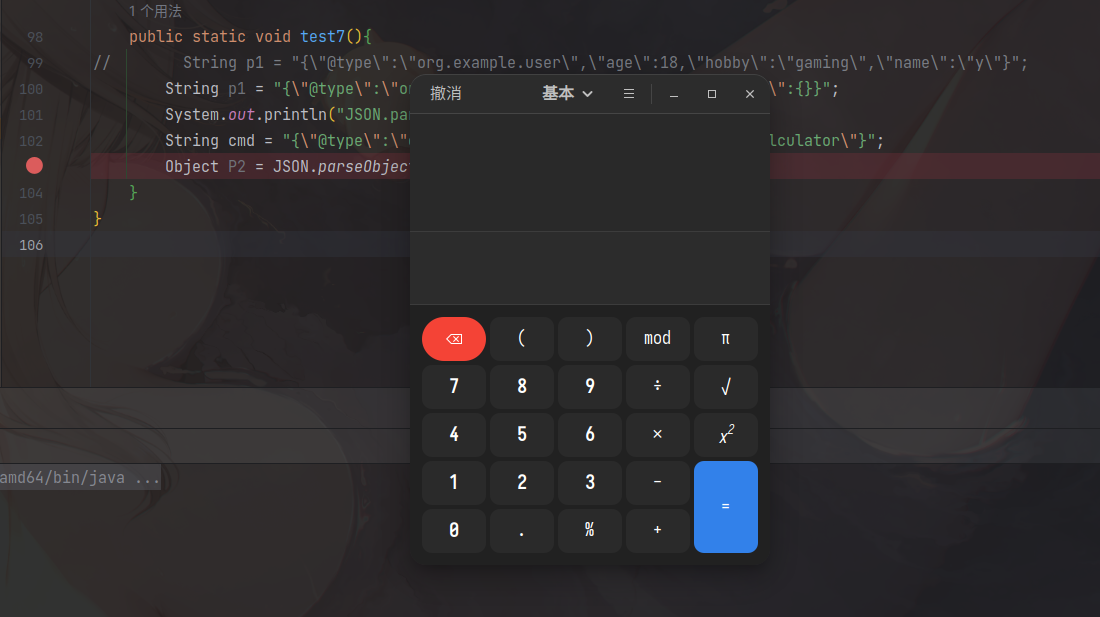
寻找利用链
没搞明白,mgj
1.2.25
之前的流程相同,在检测到DEFAULT_TYPE_KEY(@type)后,多了这一行判断
1
| Class<?> clazz = config.checkAutoType(typeName, null);
|

参考
https://tttang.com/archive/1579/#toc__2
https://www.bilibili.com/video/BV1bD4y117Qh/
https://www.cnblogs.com/nice0e3/p/14601670.html



























